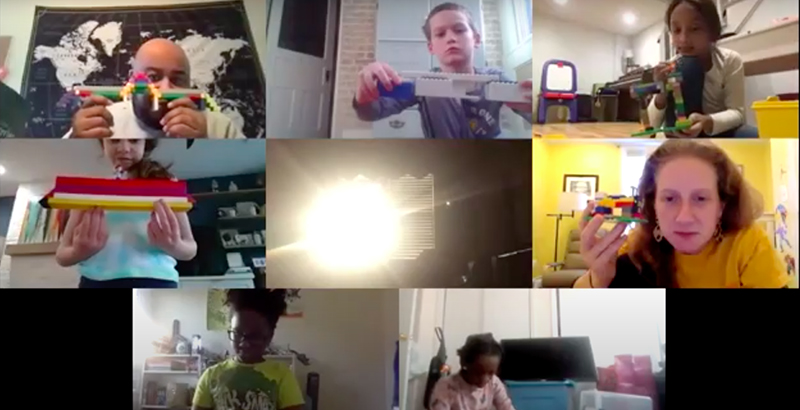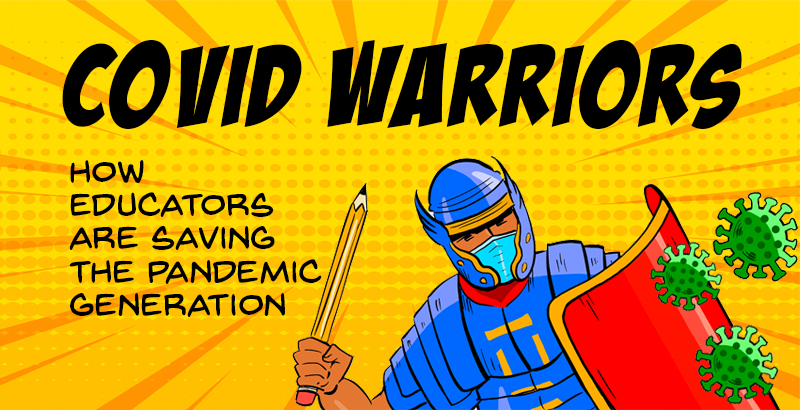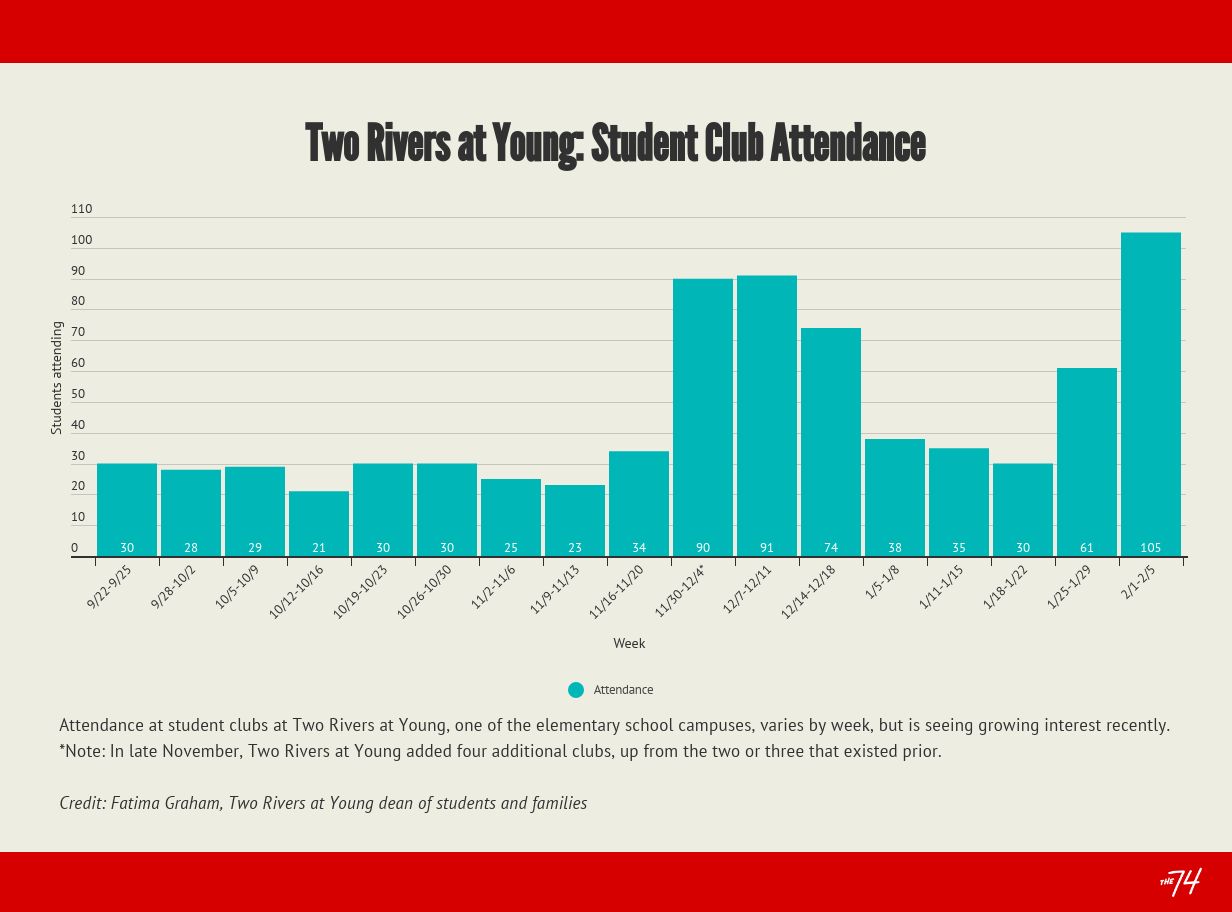Legos, Meditation, Video Field Trips: How One D.C. School Is Using Virtual Clubs to Help Students Break Through the Isolation — and Reconnect With Friends — During the Pandemic

This piece is part of “COVID Warriors: How Educators Are Saving the Pandemic Generation,” a two-week series produced in collaboration with the Solutions Journalism Network that explores what educators, schools, and districts are doing to prevent an entire generation of students from lost learning and its lifetime of consequences. Read all the pieces in this series as they are published here. Catch up on all of our solutions-based coverage here.
Zoom classes were out for the day at Two Rivers’ 4th St Elementary School in D.C., but a group of students were still online, intently building bridges out of multicolored Legos.
“I added a railing — and there’s also a little trap in there,” one student said giggling, holding hers up. “We’re not going on some of these bridges!” another student replied.
Responding to families’ requests to help students feel connected during the pandemic, Two Rivers Public Charter Schools has created Lego Club and more than a dozen other virtual student clubs since last fall.
As many students nationwide remain isolated from other kids while learning virtually, the charter network’s weekly half-hour clubs are giving children — more than 100 a week as of early February — “time and the space” to be with one another doing activities they enjoy, said Fatima Graham, dean of students and families at Two Rivers’ Young Elementary School.
Click here to see the full COVID Warriors series
Younger students especially are “really craving that connection,” added Emily Rubin, the dean of students and families at 4th Street Elementary, the network’s other primary school. “I’d gotten some feedback from parents that was like, ‘My fifth grader wants to see fourth graders. They want to be able to interact with kids that aren’t just in their Zoom classroom.’”
The clubs, which are held either after school or during lunch and attract about a dozen kids each, run the spectrum of student interests. There’s drawing club, where students bring creations like zombie sharks to life. Mindfulness Club, where students practice breathing exercises and soothing activities like outlining their hands with pencil. Social Club, where the agenda might include embarking on a virtual hiking trip and scouring one’s house for necessary provisions and clothing.
It’s an undertaking that’s paying off, with many students embracing the clubs as a way to stay connected to classmates, handle pandemic-related stress and explore their hobbies.
“I like it, one, for the social aspect,” said Tamara Brown, a Ward 8 mom whose fifth grade daughter helps lead a 4th Street club for creative writing. It’s an educational opportunity, too — “a way for her to be able to continue with her passion, and also for her to learn” to be a better writer, she added.
Ajulu Oluka, a pre-K assistant teacher at Young, has heard from colleagues the clubs have made Zoom classes more lively as well. Students “see that they have common interests in these clubs, and so in the classroom they engage more with each other,” she said.
The charter network, which serves about 860 students, has always emphasized community, Graham and Rubin told The 74. Pre-pandemic there were weekly school-wide meetings, with singalongs and birthday shout-outs. The charter’s schools feel inviting, the walls painted bright blues, yellows and greens.
The transition to virtual learning left a noticeable gap. Parent survey results released in October revealed nearly half of families cited “peer connection” as an area of remote learning needing improvement. Many teachers saw a need, too, Rubin added, but struggled to find time in their “tapped” schedules to craft social activities.
“That was where Fatima and I both, with our leadership teams, were like OK, how can we run some different clubs?” she said.
Apart from limited in-person services, all-virtual learning is expected to continue at Two Rivers through at least the end of March.
Themed, online student clubs are a new, home-grown venture for Two Rivers. Previously, afterschool programming was run in-person and primarily by the network’s after care provider and outside agencies, Rubin said. Graham and Rubin started running a handful of virtual clubs at their respective campuses serving a few dozen students around late September, with weekly attendance growing as the number of clubs expanded.
Like online classes, virtual clubs have presented challenges. A student’s Internet connection may lag. Some meeting times have had to shift because they weren’t working with families’ schedules. Attendance ebbed for a few weeks after the holidays. Sometimes parents or students might miss the Zoom links for the clubs that are posted in Google Classroom. Or there’s Zoom fatigue: “We struggle with the balance of … how much screen time” our child should have, parent Brown said.
Graham and Rubin don’t know whether the clubs are directly influencing classroom attendance or performance in school — though outside research suggests a correlation between students participating in extracurriculars and having both fewer unexcused absences and higher academic aspirations.
They’re not relying solely on club attendance to define success, either. Rather, they’re driven by questions like, “Is there a need or an interest in your community for this, and is that club meeting the need?” Graham said. “Even if it’s not [a packed club], what is it providing for these kids” who do participate?
Those questions are being answered in many different ways. Fifth grader Merrick said he’s a dedicated drawing club attendee at Young because drawing is a way “to feel like you’re really in control of what you’re doing.” He also likes “just being in a space doing something I really like.”

One student logs on to Graham’s social club while eating lunch — not to participate, she said, but just to be with other kids.Assistant teacher Oluka, who helps run mindfulness club, said parents have told her they see their kids using their newly learned breathing exercises, especially when cooped up with their younger siblings.
Oluka even has found personal value participating. “It helps me to calm my body down and just have that time to reflect on what I can do better, or what I need to work on,” she said.
In a few cases, students have even pitched their own clubs. Fifth grader Kenadie Brown co-runs 4th Street’s virtual writing club on Wednesday afternoons with her best friend. She researches fun open-ended writing prompts before each meeting, and hopes to tap her third and fourth grade club members to start a student newsletter.
“In my English class, we usually just work on … school work, while writing club is more fun,” and kids “are really happy and really passionate” about the activities, Kenadie said. She added that, “I’m in school most of the day, so being able to have Wednesday to connect with other peers in the school is very good for me.”
Two Rivers is not the only D.C. school pioneering ways to connect students virtually.
Capital City Public Charter School, for example, is running clubs like art club, acting club and cooking club, with one goal being to help its English learner population continue “hearing and learning” English, head of school Karen Dresden said. Many DCPS schools are hosting their normally in-person clubs virtually, too, from robotics to choir practices, spokeswoman Liz Bartolomeo said.
Clubs like the ones Two Rivers has created should be replicable across schools, Graham said, noting that, “Especially now during the pandemic, people are going to need to think about” offering this kind of programming for kids’ emotional well-being, “even if it’s not [typically] top of mind.”
But she and Rubin acknowledged Two Rivers has a few advantages: A longstanding emphasis on social-emotional learning, and dedicated staff positions — which they both hold — for improving school culture.
The network also acquired recent grant funding of up to $5,000 per campus from Capitol Hill Community Foundation, allowing them to bring in outside partners, like Silver Knights to teach chess and Robotics For All to teach kids to code.
What the clubs will look like moving forward and into next school year remains an open question; Rubin and Graham said they want to continue being responsive to students’ needs. The network is beginning “to disaggregate data to see if we are providing equitable opportunities to all student groups,” the network’s executive director Kristina Kyles-Smith wrote in an email.
The consensus seems to be that — in some format — they’re here to stay.
“You can’t just rewind and forget that there have been shifts that have happened,” Graham said. “I think we learn from how we’ve launched [these clubs] now and the success they’ve had and determine how we continue it in-person, or hybrid, or however school’s going to look in the future.”
Get stories like these delivered straight to your inbox. Sign up for The 74 Newsletter



